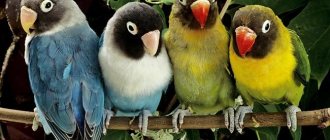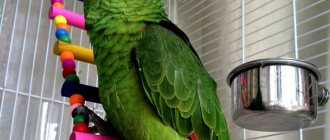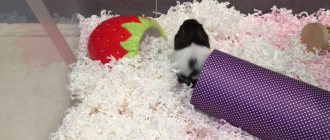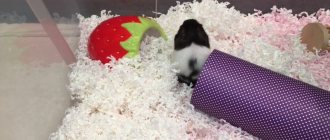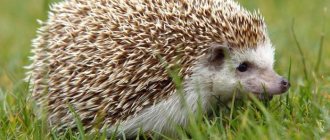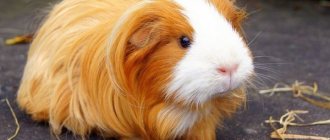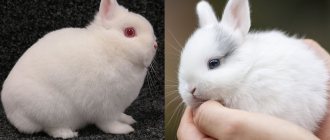The question of how to choose a parrot often arises among those who want to acquire a feathered friend. This is a responsible matter and must be approached with all seriousness - you will have to constantly take care of the bird, feed it properly, monitor its health, and educate it so that the pet becomes not just a noisy creature, but brings joy to the house.
Optimal age to buy
Young birds are more active than adults and are easier to train. Here are some tips for choosing the right young parrots:
- purchase birds only in trusted places, that is, in pet stores or from trusted breeders;
- it is advisable that the age of the bird at the time of purchase does not exceed four months (you will obtain this information from your sales consultant or breeder);
- You should not take birds under four weeks of age, because... they may not yet be completely independent;
- parrots brought from the wild are noisier and louder than birds raised in captivity.
Responsibility
Some bird species, especially beaked birds, require daily exercise, companionship and freedom outside the cage. Can you spend at least two hours a day interacting with and supervising your parrot outside of the cage? If not, then a finch, canary, or other more independent species may be better for you. To ensure that your parrot is healthy and happy, you must consider how much time you have to spend with him. You also have to factor in the time spent cleaning their cage, feeding and cleaning cups, and visiting the veterinarian to make sure your bird is healthy.
How to choose a parrot
Pet parrots
Before you go shopping for a parrot, determine a few main selection criteria.
- View. When buying birds for the first time, you should opt for lovebirds, budgies or cockatiels. These representatives of birds are easy to care for, they are active and cheerful, easy to train and can even talk. Experienced owners can consider macaws or cockatoos, but these birds require much more attention. Their character is complex and capricious.
- Bird size. Large breeds include: Amazon, Gray, cockatoo and macaw. Medium-sized birds are rosella, small birds are lovebirds, cockatiels and wavy ones. The main thing when choosing the size of a parrot is to take into account the size of the room itself in which the bird will be kept, the dimensions of the cage or aviary.
- Male/female. The former are distinguished by quick learning and activity, while females, on the contrary, are slower and more flexible.
- Budget. Cockatiels, wavy or lovebirds are the most affordable bird option for home breeding. Exotic birds require much higher costs compared to the first group of birds.
What size bird is best for you?
As a rule, the larger the bird, the greater the requirements for its maintenance. Large birds can be companions, but they also scream louder, spread dirt faster, and are more demanding than smaller species. For these reasons, it is generally recommended that new parrot owners start with a small to medium sized bird. The size of your bird will be important in determining how you care for your pet. Before purchasing a pet, it is important to think realistically about how many parrots you can handle (if you plan to purchase more than one parrot).
Species and breeds
Common parrots for home keeping:
- Wavy is the perfect choice for a beginner. Minimal care and maintenance costs make this bird so common. Feathered friends are chosen as follows: - male parrots have black lines on the frontal part and back, which disappear completely after molting; - eye color - black; - young birds have darker beaks than adults.
- Lovebirds. An interesting feature of this species is the strong attachment between the female and the male. They do everything as a couple - they drink and eat, preen their feathers, play and relax. These birds have bright green plumage and a red stripe on their forehead and chest. Chicks are easier to train than adults. A distinctive feature of the chicks is the black base of the beak and lighter color of the feathers.
- Cockatiels. Easy to train, kind and talkative birds. The color of the feathers is lemon, with bright orange spots on the cheeks. How to choose the right feathered friend: - to teach a parrot to talk, its age at the time of purchase should not exceed 5 weeks. As a rule, chicks are not afraid of people and go to their own hands; - young birds have gray stripes on their tails, which disappear after the first moult; - The beak of adult birds is light, while that of chicks is dark gray.
- Jaco. Experienced poultry farmers can safely buy this wonderful, smart parrot for themselves. Grays can easily remember more than 100 words and can easily reproduce song melodies. These birds are quite large, the color of the feathers is gray, the tail has a reddish color. What you should pay attention to when choosing an exotic parrot: - buy birds no older than five months and only from trusted breeders. Chicks born in captivity are flexible, kind and learn fairly quickly. Wild birds are aggressive and capricious; - the eye color of babies is dark, while in adults the iris is yellow. In young chicks, before the first molt, gray spots can be seen on the plumage.
How to choose a healthy parrot
In order for a parrot to live a long life and delight its owner with its funny habits, you must first purchase a healthy bird. Treatment of budgerigar diseases requires the intervention of ornithologists, which will lead to large expenses. When choosing a budgie, pay attention to the signs of a healthy bird:
- Shiny clean beak.
- The thickening at the base of the beak, or cere, should be smooth. Roughness and growths may indicate health problems.
- Smooth shiny plumage. The feathers of a healthy parrot fit tightly together.
- Lively look and sparkle in the eyes.
- Clean nostrils. It is dangerous to buy a bird whose nostrils are clogged with secretions.
- Active confident movements. A healthy bird does not sit with all its feathers, but is interested in the world around it.
- A toned abdomen and chest that do not stand out from the body.
If the parrot is unkempt and alienated from its relatives, this indicates a problem. Parrots offend a sick bird and do not accept it into their community. Growths on the paws and cere, as well as dirty feathers and cloaca, also serve as a dangerous signal.
Boy or girl?
Many owners, thinking about a feathered friend, cannot determine who is preferable to them - a boy or a girl? Each of them has its own advantages and disadvantages, for example:
- Boy parrots have brighter plumage. They are energetic and restless, scream loudly, thereby trying to attract as much attention as possible. Different varieties of birds have their own signs of sex determination, for example, in wavy males, the cere is blue-lilac in color, evenly colored; Grays have a longer beak and a larger head. In cockatiels, sex can only be determined after three months, since at this age males begin to sing. After molting, male cockatiels turn gray with bright orange cheeks.
- Female parrots are often quiet and calm. The sex of various bird breeds can be determined by the following characteristics: - female budgerigars have a brown cere with light spots around the nostrils; — female grays have light-colored feathers on their bellies, their heads are slightly smaller, and their paws are wider apart than males; - a female Corella will not sing like a male when she reaches 3 months of age. And after molting, the color of her feathers will take on a light lemon tint.
How to buy talking wavy buying
A parrot's ability to reproduce sounds and words depends entirely on the pet's owner. Of course, the natural characteristics of the parrot play a significant role. It has been proven that males learn faster and can pronounce complex verbal structures. Some females can produce good results after skillful training.
In order to willingly talk to a person, the wavy must have good health. If you want to buy a talking budgie, you need to pay attention to the appearance of the bird and its activity. A healthy parrot is always in a good mood and strives to reproduce the sounds it hears. It is noteworthy that the weakest individuals become more attached to a person, which makes training more effective.
In order for a parrot to learn to speak, it is necessary to communicate with the bird daily, pronouncing words calmly. Affectionate intonation will strengthen your relationship with your pet and contribute to rapid learning.
First walks after adaptation
Experienced breeders do not recommend starting to tame a budgie in the first days. Moreover, while the bird is wild and afraid of your hands, it is dangerous to let it out of the cage. The first flights into the room can be made only after 2-3 weeks, when the parrot has already become comfortable at home and knows the situation.
It is quite possible that the first time the wavy will not be able to enter the cage on its own. The reason for this may be that it cannot find the entrance. However, do not rush to catch the bird with your hands - this may violate the fragile trust that you have built up in the first few weeks. After a few hours, the wavy will get hungry and this will motivate him to go to his native land.
If you doubt that your parrot will easily return to its cage, then listen to our tips on how to teach your budgie this simple skill.
let your parrot fly in the afternoon, when he is less active; some time before you release him, remove the feeder, let him become more hungry and start looking for food more actively; do not feed your budgie while walking, let it get used to eating only in the cage; if a wavy is looking for food and can’t find it, you can help it like this: place a saucer with food on the bottom of the cage and sprinkle a little food right on top of the cage to draw its attention to it; make a perch near the entrance to make it easier for the wavy to find its way; stay away from the cage if you see that the parrot is still afraid of you; If your pet never entered the cage, you need to wait until it gets dark and catch the wavy. This needs to be done together - one person turns off the light, the second catches the bird, puts it in a cage, and only then turns on the light. do not move the cage until the parrot gets used to its place.. Following our simple tips, your pet will easily get used to its new home
We wish your feathered friends a speedy adaptation
By following our simple tips, it will be easy for your pet to get used to its new home. We wish your feathered friends a speedy adaptation.
Smart macaw parrot
Among the macaw parrots, there are the largest and most expensive varieties. They are able to remember about 20 words. The macaw has a well-developed intellect. Just like gray parrots, macaws pronounce words quite meaningfully.
Macaws are very artistic parrots. They imitate pets and imitate the sounds they hear. The macaw can also be taught to perform various tricks and play games.
But smart macaws have a complex character. They are touchy and jealous. If a parrot is offended or in a bad mood, it can become aggressive and even bite.
The macaw's voice is sharp and shrill. These are noisy and loud parrots.
Smart parrot Amazon
The Amazon parrot also has good mental abilities. He is able to learn about 80 words, imitates human speech, copies intonation, and can also imitate various sounds. He is able to pronounce not only words, but can also produce entire sentences.
Amazons are also quite artistic. They funny parody other pets, remember melodies, can sing, and perform various tricks.
Amazons are easy to tame and are very sociable birds. They remember and easily recognize the owner among all family members. Amazons are friendly birds and easily learn new things.
